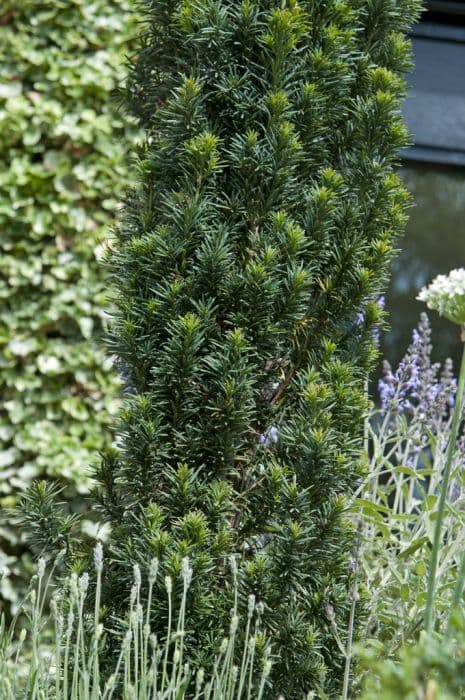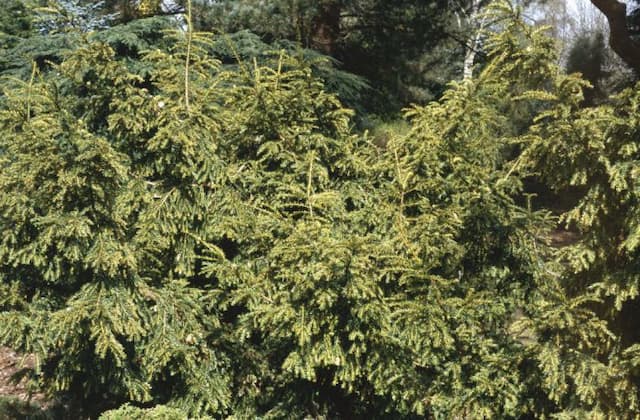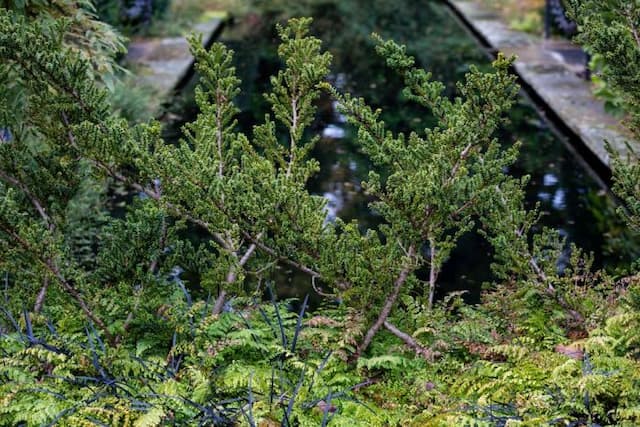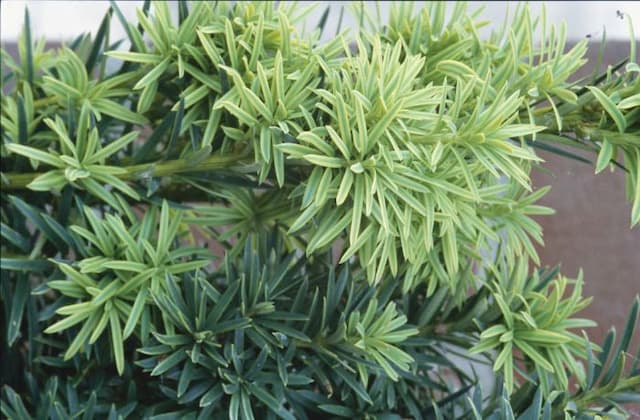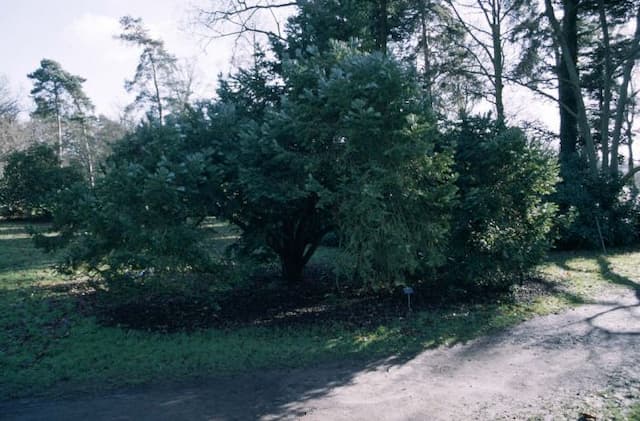Irish Yew Taxus baccata 'Fastigiata Robusta' (f)
ABOUT
The Irish yew, known as Taxus baccata 'Fastigiata Robusta' (f), is an evergreen shrub noted for its dense, upright growth habit. This conifer has dark green, needle-like leaves that are arranged in two flat rows on the branches, giving it a feathery texture. The foliage retains its rich color throughout the year. In spring, inconspicuous flowers may appear, which are followed by red, berry-like structures. These fruits add a touch of bright color against the dark foliage but are typically not prominent features. The Irish yew's branches grow in a vertical fashion, which contributes to its narrow, columnar form, and its overall appearance is that of a well-structured, elegant plant. The branches may slightly arch with age, lending a more graceful and mature look to the specimen. The bark is reddish-brown and can exfoliate in small scales, which further adds to the visual interest of this yew variety. Overall, the Irish yew presents a classic conifer silhouette with a stately and refined look, making it a popular choice for formal gardens, hedges, and as an architectural plant in various landscapes.
About this plant
 Names
NamesSynonyms
Irish Yew, Upright Yew, Fastigiate Yew
Common names
Taxus baccata 'Fastigiata Robusta' (f).
 Toxicity
ToxicityTo humans
The common name for Taxus baccata 'Fastigiata Robusta' is the English Yew. This plant is highly toxic to humans if any part is ingested, with the exception of the fleshy red aril surrounding the seed, which is not toxic. However, the seed itself is very poisonous. The toxic components are taxine alkaloids, with taxine B being the most harmful. Symptoms of English Yew poisoning can appear within a few hours and include dizziness, dry mouth, dilated pupils, weakness, heart problems such as arrhythmias, and potentially fatal changes in heart rate and blood pressure. Seizures and muscle tremors may also occur, leading to difficulty in breathing, and acute poisoning can lead to coma and death due to respiratory and cardiac failure.
To pets
The English Yew is extremely poisonous to pets as well, with dogs, cats, and horses all being susceptible to its toxic effects. Ingesting any part of the plant, apart from the red aril, can lead to severe poisoning, as the plant contains toxic taxine alkaloids. Symptoms in pets may include vomiting, diarrhea, difficulty breathing, trembling, weakness, changes in heart rate and rhythm, and potentially, sudden death from acute heart failure. Even small amounts of English Yew can be lethal, and there is no known antidote, making ingestion of this plant a veterinary emergency.
 Characteristics
CharacteristicsLife cycle
Perennials
Foliage type
Evergreen
Color of leaves
Green
Height
15-20 feet [4.5-6 meters]
Spread
6-8 feet [1.8-2.4 meters]
Plant type
Tree
Hardiness zones
6-7
Native area
Europe
Benefits
 General Benefits
General Benefits- Ornamental Appeal - Taxus baccata 'Fastigiata Robusta', commonly known as the Irish Yew, has a distinctive columnar shape which provides architectural interest in landscapes and gardens.
- Evergreen Foliage - It retains its dark green needles throughout the year, ensuring that gardens have permanent greenery even in winter.
- Drought Tolerance - Once established, this yew is relatively tolerant of drought, reducing the need for frequent watering.
- Shade Tolerance - The Irish Yew can grow well in shady conditions where other plants may struggle, making it versatile in different garden locations.
- Low Maintenance - It requires minimal pruning to maintain its shape, making it a convenient choice for both public and private spaces.
- Wildlife Habitat - Provides shelter and protection for birds and other wildlife within its dense foliage.
- Soil Adaptability - The plant is adaptable to a wide range of soil types, although it prefers well-drained soils.
- Hedge and Boundary Plant - Its dense growth habit makes it suitable for use as a hedge or a boundary plant, offering privacy and noise reduction.
 Medical Properties
Medical Properties- Taxus baccata, commonly known as the English yew, contains taxanes, specifically paclitaxel (Taxol), which are used as chemotherapeutic agents in the treatment of various cancers.
- The alkaloids found in the yew, specifically in the bark and needles, have been researched for their role in anti-cancer drugs.
- Though yew leaves have a traditional use in herbal medicine, the whole plant is toxic, and it is not used for self-medication.
 Air-purifying Qualities
Air-purifying QualitiesThis plant is not specifically known for air purifying qualities.
 Other Uses
Other Uses- Topiary and Bonsai – Taxus baccata 'Fastigiata Robusta' can be sculpted into various shapes for ornamental purposes or used for bonsai due to its slow growth and ease of pruning.
- Privacy Screens – Due to its dense foliage, it can be used to create privacy screens or hedges in gardens and parks.
- Sound Barrier – The thick foliage is also effective at absorbing sound, making it useful for planting along roads or highways to reduce traffic noise.
- Windbreak – The plant can be used as a windbreak to protect more delicate plants and reduce soil erosion in exposed areas.
- Erosion Control – Its root system helps stabilize slopes and prevent soil erosion.
- Shade for Understory Plants – It provides shade for more sensitive understory plants that cannot tolerate full sun exposure.
- Maze Gardens – It is suitable for creating living maze gardens due to its uniform columnar shape.
- Support for Climbing Plants – The robust stems can support climbing plants, allowing gardeners to create vertical gardening elements.
- Framework for Lights – During holiday seasons, its strong branches serve as a framework for decorative lights and ornaments.
- Garden Sculpture – Dead or dried specimens can be treated and used as natural garden sculptures or focal points in landscape design.
Interesting Facts
 Feng Shui
Feng ShuiThe Irish Yew is not used in Feng Shui practice.
 Zodiac Sign Compitability
Zodiac Sign CompitabilityThe Irish Yew is not used in astrology practice.
 Plant Symbolism
Plant Symbolism- Eternity: Taxus baccata, commonly known as Yew, is often associated with eternity due to its long lifespan and evergreen nature, symbolizing immortality and the enduring aspect of life.
- Resilience: Yew trees are known for their robustness and ability to withstand harsh conditions; thus they represent the ability to endure adversity.
- Transformation: The Yew is connected to transformation and rebirth because it is toxic yet can also be used medicinally, embodying the idea of death leading to life.
- Protection: Traditionally, Yew has been planted in churchyards and considered a protector of the dead, extending this symbol to a more general sense of safeguarding and sanctuary.
- Remembrance: Yew trees are often found in cemeteries, where they serve as a symbol of remembrance and the enduring memory of the departed.
 Water
WaterThe Irish Yew should be watered deeply and thoroughly, ensuring that the soil is moist without being waterlogged. During the growing season, water approximately once a week, providing about 1 to 1.5 gallons per watering for a young tree, adjusting for rainfall, temperature, and soil conditions. Mature trees will require less frequent watering, but it's critical to monitor soil moisture levels, watering when the top few inches of soil become dry. During winter, reduce the frequency of watering since the plant’s water requirements decrease.
 Light
LightThe Irish Yew thrives best in full sun to partial shade. It is well-suited for areas that receive several hours of direct sunlight but can also tolerate locations with dappled light or some shade. Avoid deep shade locations, as insufficient light can hinder the plant's growth and health.
 Temperature
TemperatureThe Irish Yew can withstand a range of temperatures, making it adaptable to various climates. It thrives in temperatures between 60°F and 70°F but can survive in temperatures as low as -30°F and as high as 100°F. However, it is important to protect the tree from extreme heat and cold by providing suitable mulch and positioning it in a location that avoids harsh winter winds.
 Pruning
PruningPruning the Irish Yew is done to maintain its shape, remove damaged branches, and promote healthy growth. The best time for pruning is in late winter or early spring before new growth starts, typically once a year. For more formal shapes, a second trimming in mid-summer may be necessary to tidy up any new growth.
 Cleaning
CleaningAs needed
 Soil
SoilThe Irish Yew prefers well-draining, loamy soil with a pH range of 6.0 to 7.5. A mix of two-thirds topsoil to one-third sand or perlite with added organic matter such as compost or peat moss will create the best soil conditions for growth and health.
 Repotting
RepottingThe Irish Yew is typically a slow grower and doesn't need frequent repotting; it should be repotted every 3-4 years, or when it becomes root-bound in its current container.
 Humidity & Misting
Humidity & MistingThe Irish Yew tolerates a wide range of humidity levels but prefers moderate humidity. It is quite adaptable and does not require special humidity adjustments.
 Suitable locations
Suitable locationsIndoor
Provide bright, indirect light and avoid dry, hot spots indoors for Irish Yew.
Outdoor
Plant in partial shade to full sun, shelter from strong winds for Irish Yew.
Hardiness zone
6-8 USDA
 Life cycle
Life cycleTaxus baccata 'Fastigiata Robusta', also known as the Upright European Yew, starts its life as a seed, which requires a moist, cool period to germinate, a process known as cold stratification. After germination, the seedling begins to grow, developing into a young plant with a straight stem and a conical crown, characteristic of its cultivar. As it matures, it develops dark green needles and, being dioecious, may produce either male cones that release pollen or female cones that, after pollination, develop into red, berry-like structures called arils. Over several decades, the Upright European Yew will slowly grow into a dense, columnar tree, withstanding pruning well, which allows it to be used in formal gardens and hedges. It can live for hundreds of years, during which it continues a slow rate of growth, reaching substantial heights and widths if untrimmed. Finally, as it nears the end of its life cycle, the older yew may become hollow but can continue to support a range of wildlife until it dies and decomposes, returning nutrients to the soil.
 Propogation
PropogationPropogation time
Late Summer to Early Autumn
Propogation: The most popular method for propagating the Taxus baccata 'Fastigiata Robusta', commonly known as the Irish Yew, is through semi-hardwood cuttings. This technique typically takes place in late summer to early fall, as this timing allows the cuttings to establish roots while the weather is still warm. To propagate by cuttings, a piece of stem from the current season's growth, about 4 to 6 inches (10 to 15 cm) long, is taken with a sharp, sterilized pruning tool. These cuttings should include several sets of leaves and are best treated with rooting hormone before being planted into a mix of equal parts peat and perlite or sand to encourage root growth. The cuttings should be kept in a well-lit area but out of direct sunlight, ensuring that the growing medium is consistently moist, but not waterlogged, to facilitate root development. With proper care, the cuttings will develop their root systems within a few months, after which they can be transplanted to their permanent location.
